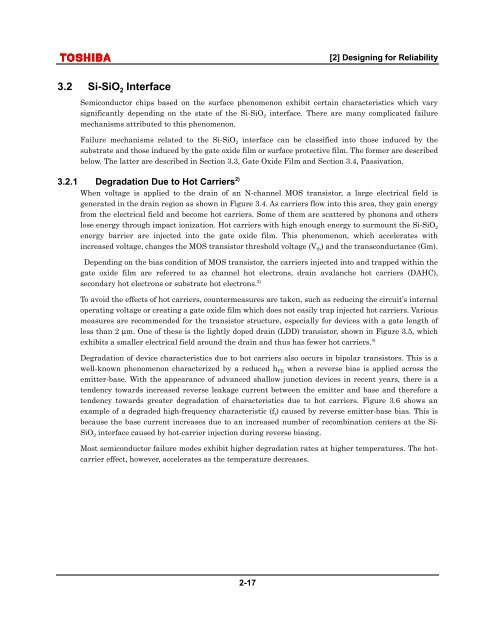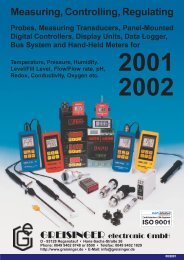1. Basic Concepts in Reliability Design - nl3prc
1. Basic Concepts in Reliability Design - nl3prc
1. Basic Concepts in Reliability Design - nl3prc
You also want an ePaper? Increase the reach of your titles
YUMPU automatically turns print PDFs into web optimized ePapers that Google loves.
[2] <strong>Design</strong><strong>in</strong>g for <strong>Reliability</strong>3.2 Si-SiO 2 InterfaceSemiconductor chips based on the surface phenomenon exhibit certa<strong>in</strong> characteristics which varysignificantly depend<strong>in</strong>g on the state of the Si-SiO 2 <strong>in</strong>terface. There are many complicated failuremechanisms attributed to this phenomenon.Failure mechanisms related to the Si-SiO 2 <strong>in</strong>terface can be classified <strong>in</strong>to those <strong>in</strong>duced by thesubstrate and those <strong>in</strong>duced by the gate oxide film or surface protective film. The former are describedbelow. The latter are described <strong>in</strong> Section 3.3, Gate Oxide Film and Section 3.4, Passivation.3.2.1 Degradation Due to Hot Carriers 2)When voltage is applied to the dra<strong>in</strong> of an N-channel MOS transistor, a large electrical field isgenerated <strong>in</strong> the dra<strong>in</strong> region as shown <strong>in</strong> Figure 3.4. As carriers flow <strong>in</strong>to this area, they ga<strong>in</strong> energyfrom the electrical field and become hot carriers. Some of them are scattered by phonons and otherslose energy through impact ionization. Hot carriers with high enough energy to surmount the Si-SiO 2energy barrier are <strong>in</strong>jected <strong>in</strong>to the gate oxide film. This phenomenon, which accelerates with<strong>in</strong>creased voltage, changes the MOS transistor threshold voltage (V th ) and the transconductance (Gm).Depend<strong>in</strong>g on the bias condition of MOS transistor, the carriers <strong>in</strong>jected <strong>in</strong>to and trapped with<strong>in</strong> thegate oxide film are referred to as channel hot electrons, dra<strong>in</strong> avalanche hot carriers (DAHC),secondary hot electrons or substrate hot electrons. 3)To avoid the effects of hot carriers, countermeasures are taken, such as reduc<strong>in</strong>g the circuit’s <strong>in</strong>ternaloperat<strong>in</strong>g voltage or creat<strong>in</strong>g a gate oxide film which does not easily trap <strong>in</strong>jected hot carriers. Variousmeasures are recommended for the transistor structure, especially for devices with a gate length ofless than 2 µm. One of these is the lightly doped dra<strong>in</strong> (LDD) transistor, shown <strong>in</strong> Figure 3.5, whichexhibits a smaller electrical field around the dra<strong>in</strong> and thus has fewer hot carriers. 4)Degradation of device characteristics due to hot carriers also occurs <strong>in</strong> bipolar transistors. This is awell-known phenomenon characterized by a reduced h FE when a reverse bias is applied across theemitter-base. With the appearance of advanced shallow junction devices <strong>in</strong> recent years, there is atendency towards <strong>in</strong>creased reverse leakage current between the emitter and base and therefore atendency towards greater degradation of characteristics due to hot carriers. Figure 3.6 shows anexample of a degraded high-frequency characteristic (f t ) caused by reverse emitter-base bias. This isbecause the base current <strong>in</strong>creases due to an <strong>in</strong>creased number of recomb<strong>in</strong>ation centers at the Si-SiO 2 <strong>in</strong>terface caused by hot-carrier <strong>in</strong>jection dur<strong>in</strong>g reverse bias<strong>in</strong>g.Most semiconductor failure modes exhibit higher degradation rates at higher temperatures. The hotcarriereffect, however, accelerates as the temperature decreases.2-17





